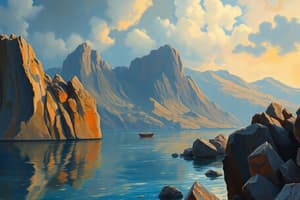Podcast
Questions and Answers
What are the three main types of rocks?
What are the three main types of rocks?
Igneous, Sedimentary, Metamorphic
Why are rocks important for our planet?
Why are rocks important for our planet?
Rocks provide materials for construction, technology, and art.
How does the rock cycle contribute to the ever-changing nature of Earth's surface?
How does the rock cycle contribute to the ever-changing nature of Earth's surface?
It describes the transformation of rocks from one type to another.
What might the texture of an igneous rock tell us about how it was formed?
What might the texture of an igneous rock tell us about how it was formed?
How do sedimentary rocks reveal Earth's history?
How do sedimentary rocks reveal Earth's history?
Can you think of any uses for metamorphic rocks in construction?
Can you think of any uses for metamorphic rocks in construction?
How might the appearance of a metamorphic rock reflect its history?
How might the appearance of a metamorphic rock reflect its history?
What is the rock cycle and why is it significant in geology?
What is the rock cycle and why is it significant in geology?
How do plate tectonics contribute to the rock cycle?
How do plate tectonics contribute to the rock cycle?
How does the rate of cooling affect the size of crystals in igneous rocks?
How does the rate of cooling affect the size of crystals in igneous rocks?
What role do rivers and oceans play in the transport and deposition of sediments?
What role do rivers and oceans play in the transport and deposition of sediments?
What might trigger the metamorphic process in a rock?
What might trigger the metamorphic process in a rock?
Why is soil considered an essential component of the Earth's ecosystem?
Why is soil considered an essential component of the Earth's ecosystem?
Flashcards are hidden until you start studying
Study Notes
The Three Main Categories of Rocks
- Rocks are solid natural substances composed of minerals; they form Earth's crust.
- The three main types of rocks are igneous, sedimentary, and metamorphic, each with unique formation processes.
The Rock Cycle
- The rock cycle illustrates the continuous transformation of rocks due to natural processes.
- Igneous rocks can change into sedimentary or metamorphic rocks; sedimentary rocks may metamorphose or melt into magma; metamorphic rocks can melt or become sedimentary.
Igneous Rocks
- Formed from the cooling and solidification of magma or lava.
- Divided into intrusive (cooled inside Earth) and extrusive (cooled on the surface).
- Examples: Granite (intrusive) and Basalt (extrusive).
- Texture varies based on cooling rate; fast cooling forms small crystals (extrusive), while slow cooling leads to large crystals (intrusive).
Sedimentary Rocks
- Created from accumulated sediment over time, often containing layers and fossils.
- Form through processes of compaction and cementation over millions of years.
- Examples include Sandstone and Limestone, which can reveal Earth's historical environments through their layers.
Metamorphic Rocks
- Formed under extreme pressure and temperature, transforming original rocks (protoliths).
- Two types: Foliated (layered appearance, e.g., Slate) and Non-foliated (no layers, e.g., Marble).
- Metamorphic rocks can be used in construction and art due to their unique properties.
Identifying Rocks
- Igneous Rocks: Look for crystal size (fine vs. coarse), color indicating mineral composition, and density differences.
- Sedimentary Rocks: Check for layered appearance, fossils, and grain size/shape.
- Metamorphic Rocks: Observe for foliation, texture variations, and crystalline appearances.
Environmental Impact of Rock Mining
- Mining can result in habitat destruction, pollution, and soil erosion; sustainable practices are essential to minimize damage.
Uses of Rocks
- Igneous Rocks: Granite for countertops; Basalt for construction; Pumice in cleaning products.
- Sedimentary Rocks: Limestone in cement; Sandstone for tiles and paving; Coal as an energy source.
- Metamorphic Rocks: Marble for sculptures; Slate for roofs and flooring.
Rock Cycle Dynamics
- The rock cycle involves processes like plate tectonics, where Earth's plates create mountains and initiate volcanic activity.
- Erosion and sedimentation are key in forming sedimentary rocks, while heat and pressure lead to metamorphism.
Soil and Ecosystem
- Soil is formed from weathered rocks and organic materials; it plays a critical role in the ecosystem.
- Different rock types affect soil properties, contributing to agricultural and natural environments.
Reflection of Earth's History
- The rock cycle provides insights into Earth's geological history and the evolution of the planet over time.
Studying That Suits You
Use AI to generate personalized quizzes and flashcards to suit your learning preferences.




